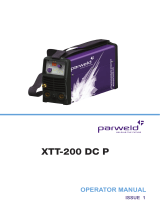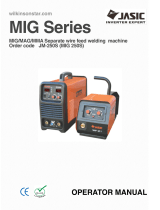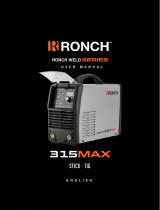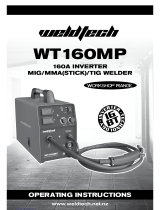
EN
Multiprocess 175. Operating manual.Multiprocess 175. Operating manual. 1110
also has the effect of increasing the resistive heating on the wire further
accentuating the drop in welding current. Research has also shown
that increasing this distance can lead to an increase in the ingress of
nitrogen and hydrogen into the weld pool, which can affect the quality
of the weld.
Flux-cored arc welding has a lower efficiency than solid wire MIG/
MAG welding because part of the wire fill contains slag forming agents.
Although the efficiency varies by wire type and manufacturer it is
typically between 75–85%.
Flux-cored arc welding does, however, have the same drawback as solid
wire MIG/MAG in terms of gas disruption by wind, and screening is
always necessary for site work. It also incurs the extra cost of shielding
gas, but this is often outweighed by gains in productivity.
Self-shielded operation
There are also self-shielded consumables designed to operate without
an additional gas shield. In this type of product, arc shielding is provided
by gases generated by decomposition of some constituents within the
flux fill. These types of wire are referred to as ‘self-shielded’.
If no external gas shield is required, then the flux fill must provide
sufficient gas to protect the molten pool and to provide de-oxidisers and
nitride formers to cope with atmospheric contamination. This leaves less
scope to address performance, arc stabilisation, and process tolerance,
so these tend to suffer when compared with gas shielded types.
Wire efficiencies are also lower, at about 65%, in this mode of operation
than with gas shielded wires. However, the wires do have a distinct
advantage when it comes to site work in terms of wind tolerance, as
there is no external gas shield to be disrupted.
When using self-shielded wires, external gas supply is not required and,
therefore, the gas shroud is not necessary. However, an extension nozzle
is often used to support and direct the long electrode extensions that
are needed to obtain high deposition rates.
2.3 Introduction to Metal-Cored Arc Welding (MCAW)
How it works
Metal-cored arc welding (MCAW) uses the heat generated by a DC
electric arc to fuse metal in the joint area, the arc being struck between
a continuously fed consumable filler wire and the workpiece, melting
both the filler wire and the workpiece in the immediate vicinity. The
entire arc area is covered by a shielding gas, which protects the molten
weld pool from the atmosphere.
As MCAW is a variant of the MIG/MAG welding process there are many
common features between the two processes, but there are also several
fundamental differences.
As with MIG/MAG, direct current power sources with constant voltage
output characteristics are normally employed to supply the welding
current. With metal-cored wires the terminal the filler wire is connected
to depends on the specific product being used, some wires designed
to run on electrode positive, others preferring electrode negative, and
some which will run on either. The work return lead is then connected
to the opposite terminal. Electrode negative operation will usually give
better positional welding characteristics. The output characteristics
of the power source can have an effect on the quality of the welds
produced.
The wire feed unit takes the filler wire from a spool or bulk pack, and
feeds it through the welding torch, to the arc at a predetermined and
accurately controlled speed. Normally, special knurled feed rolls are used
with metal-cored wires to assist feeding and to prevent crushing the
consumable.
Unlike MIG/MAG, which uses a solid consumable filler wire, the
consumable used in MCAW is of tubular construction, an outer metal
sheath being filled entirely with metal powder except for a small amount
of non-metallic compounds. These are added to provide some arc
stability and de-oxidisation.
MCAW consumables always require an auxiliary gas shield in the
same way that solid MIG/MAG wires do. Wires are normally designed
to operate in argon-carbon dioxide or argon-carbon dioxide-oxygen
mixtures or carbon dioxide. Argon rich mixtures tend to produce lower
fume levels than carbon dioxide.
As with MIG/MAG, the consumable filler wire and the shielding gas are
directed into the arc area by the welding torch. In the head of the torch,
the welding current is transferred to the wire by means of a copper
alloy contact tip, and a gas diffuser distributes the shielding gas evenly
around a shroud which then allows the gas to flow over the weld area.
The position of the contact tip relative to the gas shroud may be adjusted
to limit the minimum electrode extension.
Modes of metal transfer with MCAW are very similar to those obtained
in MIG/MAG welding, the process being operable in both ‘dip transfer’
and ‘spray transfer’ modes. Metal-cored wires may also be used in
pulse transfer mode at low mean currents, but this has not been widely
exploited.
2.4 Modes of metal transfer
The mode or type of metal transfer in MIG/MAG and MCAW welding
depends upon the current, arc voltage, electrode diameter and type of
shielding gas used. In general, there are four modes of metal transfer.
Modes of metal transfer with FCAW are similar to those obtained in MIG/
MAG welding, but here the mode of transfer is heavily dependent on the
composition of the flux fill, as well as on current and voltage.
The most common modes of transfer in FCAW are:
→Dip transfer
→Globular transfer
→Spray transfer
Pulsed arc transfer operation has been applied to flux-cored wires but,
as yet, is not widely used because the other transfer modes are giving
users what they require, in most cases.
Dip transfer
Also known as short-circuiting arc or short-arc, this is an all-positional
process, using low heat input. The use of relatively low current and arc
voltage settings cause the electrode to intermittently short-circuit with
the weld pool at a controlled frequency. Metal is transferred by the wire
tip actually dipping into the weld pool and the short-circuit current is
sufficient to allow the arc to be re-established. This short-circuiting mode
of metal transfer effectively extends the range of MIG/MAG welding to
lower currents so thin sheet material can readily be welded. The low
heat input makes this technique well-suited to the positional welding
of root runs on thick plate, butt welds for bridging over large gaps and
for certain difficult materials where heat input is critical. Each short-
circuit causes the current to rise and the metal fuses off the end of the
Process schematic diagram for MIG/MAG, FCAW and MCAW
1 Gas cylinder, 2 Gas hose, 3 Continous wire, 4 Wire feed unit, 5 Power cable, 6 Torch conduit, 7 Welding torch, 8 Arc, 9 Workpiece, 10 Earth clamp, 11 Return cable,
12 Power source
2
1
12
11
5
6
4
3
10
9
8
7
Schematic of dip transfer
1 Short circuit, 2 Necking, 3 Arc re-ignition, 4 Arc established, 5 Arc gap shortens,
6 Short circuit
Time
Short circuit cycle Arcing cycle
Current (A)
Voltage (V)
1 2 3 4 5 6


























